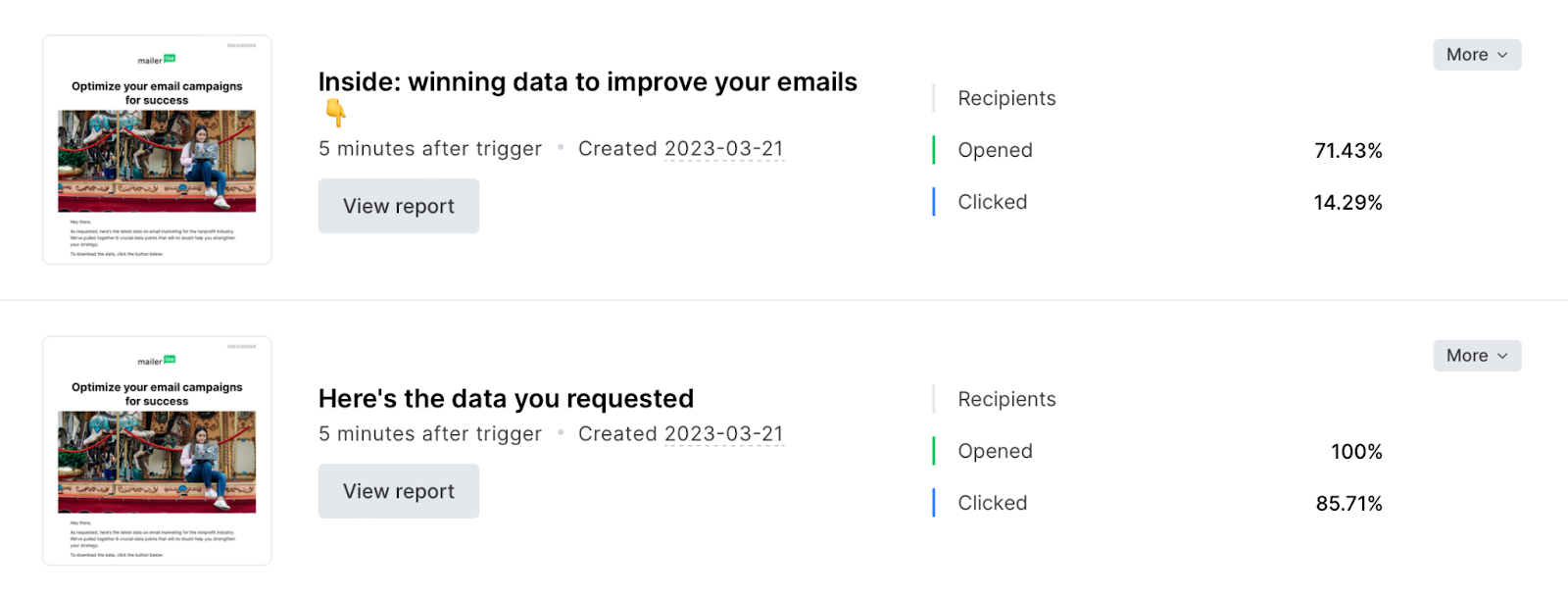Email marketing for small businesses—the ultimate guide

Small businesses love email marketing because it’s cost-effective and delivers the best return-on-investment (ROI) on the planet. But, you have to do it right.
Email marketing works best when you stick to the fundamentals and build and nurture subscribers so that they become long-term customers.
This guide to email marketing for small businesses is your resource center. You’ll find tips, tricks, and know-how to help you grow and manage an email marketing operation with a return on investment that’ll put a smile on your face.
Go ahead and bookmark this guide and refer back to it as you fine-tune each aspect of your email marketing set-up. Good luck!
What is email marketing for small businesses?
Email marketing for small businesses is the strategy of collecting email subscribers and sending them content and offers that will turn them into customers.
Small businesses tend to put email at the center of their digital marketing efforts because it’s a low-cost, effective way to build an audience and generate sales. It’s also one of the only "owned" channels—you own your email list forever and you control your content.
This compares to growing an audience you don’t own on social media, where the visibility of your content and access to your followers is always at the mercy of the platform’s algorithm.
Benefits of small business email marketing
In addition to being cost-effective and owning your subscriber list, email marketing enables you to personalize the customer experience, which builds trust, drives traffic, and generates leads. What else could you ask for?!
Create landing pages or embed signup forms on your website to collect the email addresses of potential customers who have yet to make a purchase, and nurture them into a sale.
Use cross-selling and upselling in your email campaigns to recommend upgrades or complementary products that subscribers might enjoy. This will allow you to increase sales and average order value (AOV).
Check out these “non-pushy” upselling techniques.
By providing subscribers with valuable content and keeping them informed about what's going on with your business, you earn their trust and establish yourself as a credible source of information.
When you provide valuable content and relevant offers in your emails, include links to your website with a clear call-to-action so they can continue learning more about your business.
Ready to capture more leads and drive sales?
Try MailerLite, the email marketing platform your small business needs, and the industry leader in email deliverability.
How to do small business email marketing right
When you get the fundamentals right, your email marketing will run like a well-oiled machine and the sky's the limit. We’ve identified the most important building blocks and created guides for each step of the process.
1. Choose the right email marketing platform
There are SO many options available when it comes to choosing your email marketing software. It can honestly be quite overwhelming! So before you get started on your hunt for the ultimate ESP (Email Service Provider), it’s a good idea to note down a few key criteria. This way, you’ll be able to effectively measure up each candidate against your needs and constraints.
You should consider:
Features: What are the features your small business absolutely needs, which would be nice to have, and does the solution offer them? Some significant features to think about include automation, segmentation, email template editors, integrations, and A/B testing
Cost: What’s your budget and which ESPs fit within it or provide the most value for it?
Deliverability: Deliverability is the ability for your emails to reach subscribers’ inboxes. It’s important because deliverability varies across ESPs and you want to ensure you’re paying for a service that delivers results.
Customer support: What kind of support does the ESP offer and which channels is support available on? Do they help with onboarding? Simple, accessible, human customer support is important for small businesses, as you’ll want quick resolutions to any issues so you can go back to focusing on all of the many other tasks you have.
Usability: When you’re running and growing a small business, the more simple and user-friendly your ESP, the better! Look for an email marketing platform that is modern, intuitive and easy to learn without compromising on functionality or features.
Scalability: You have a small business now but the goal is to grow—will your ESP be able to grow with you? Check out the pricing plans to understand how they’re structured. Does the ESP make it easy and affordable to upgrade and send more emails, plus provide the features you’ll need, when the time comes to expand?
2. Build a high-quality subscriber list
Email marketing is a unique marketing channel because your audience gives you permission to talk to them. It’s a relationship that must be maintained just like your everyday friendships.
These relationships start by attracting people to your business and inviting them to sign up and opt-in to your email list. This is a never-ending process that is the lifeblood of email marketing.
Create signup forms and landing pages
To start collecting subscribers, you’ll want to create signup forms, pop-ups and landing pages where people can opt in.
When you create forms and pop-ups with an ESP, you can easily embed them into your website so that whenever somebody signs up, they’ll be automatically added to your email list. You can also customize the forms so they get added to the subscriber group of your choosing.
Use lead magnets
Lead magnets are free resources that people can access by providing their email address. They’re great for growing your email list with people who are genuinely interested in your content and what you have to offer.
The key is to make your lead magnet in-depth, valuable, and worth someone handing over their email for—it should solve a problem for the subscriber. Some examples of lead magnets include e-books, checklists, templates, workbooks, tools, free trials, and research reports.
You have everything you need in MailerLite to build a healthy subscriber list by using landing pages, signup forms, pop-ups or a website builder where you can develop new content to attract new people.
3. Let automation do the work for you
The last time you subscribed to an email newsletter, did you receive an email a few minutes after to welcome you? It wasn’t a human who sent the welcome email—it was email marketing automation.
Automation tools aren’t as complicated as you might think. They’re also essential for small businesses with limited time and resources.
Email automation allows you to set up an email sequence just once and then automatically send that sequence to everyone who triggers it without lifting a finger. This means you can focus your efforts elsewhere while your email works for you.
According to Fluent CRM, the top 3 ways email automation benefits small businesses are reported to be:
It saves time (30%)
It generates leads (22%)
It increases revenue (17%)—it’s reported that automated emails generate an astounding 320% more revenue than non-automated emails!
Email automation for small business ideas
Need some inspiration to help you get started with email automation for your small business? Here are a few simple ideas you can start working on today.
1. Welcome email. Every time a new subscriber signs up, they’ll automatically get a welcome email. You can include a little bit about your brand/company, let subscribers know what to expect from you in future emails, and add a special discount code or offer to say thanks for joining.
2. Abandoned cart email. Whenever a customer (who’s signed in to your website) adds something to their cart but then exits without completing the purchase, you can send an abandoned cart email to give them a little nudge towards checking out. Average cart abandonment rate is 70.19% so if you can recover even just a small percentage of that, it’s a win!
3. Review request email. Displaying reviews on your website can increase conversions by up to 270% and 80% of people are more likely to buy products with reviews. That’s significant! The easiest way to get reviews is to reach out to customers while their experience with you is still top of mind. And the easiest way to do that for your small business is with email automation!
To learn more about creating review requests that get results and the best times to send them for different industries, check out our guide on how to create review request emails.
4. Nurture emails. Having automated lead nurture emails is kind of like having a team of salespeople working for you 24/7. They’re designed to transport leads down the sales funnel, building strong customer relationships along the way. These emails are set up to be triggered based on certain characteristics and actions, so they reach the right people at the right time, resulting in increased sales, revenue and profit.
Some types of emails you could include in your nurture automations include product explainers, educational content, product updates, social proof, webinars, and special offers or discounts. Check out our complete guide to nurture email campaigns to learn more.
5. Special events emails. An easy way to showcase your brand personality and connect with subscribers is to send automated emails for special events or dates. A popular example is to send a birthday message on the subscriber’s birthday, sometimes with a special gift such as a discount code (which also helps boost sales!).
You can do really cool things with email automation for small business! Want to learn more? Check out our guide on email automation and how you can use it to grow your business.
4. Design effective email campaigns
To create engaging email campaigns for small businesses, you first need to define what your audience and goals are.
To do this, ask yourself the following:
Who your campaign is targeting?
What do they care about?
What are their challenges and pain points?
What are you hoping to achieve with your campaign?
Do you want to increase sales, boost brand recognition, or something else?
When you answer these questions, it will be much easier to design emails and create content that engages your audience and helps you achieve your goals.
Craft emails people care about
Your new subscribers trust you to send emails that matter to them. You made a promise when they signed up that you would deliver a certain type of content. Before you send out an email, ask yourself if you are providing value for them.
Remember, readers can unsubscribe at any time. Email marketing is a transaction. People give you their time and attention and in return, they want something for it like quality content, news, or special offers, to name a few.
Read this guide to writing engaging email content, so you can set a solid strategy for your small business.
Write eye-catching subject lines
Imagine the hundreds of promotional emails that come through your subscribers’ inboxes every day. At some point, people simply scan their marketing emails to see what grabs their attention and 47% of recipients will open an email based on the subject line alone.
MailerLite’s AI subject line generator makes crafting the perfect subject line simple by combining creativity with optimized language for subject lines that catch subscribers’ attention while clearly defining what the email contains.
Read our guiding principles to writing effective subject lines where we provide email marketing tips that will help you improve your open rates.
Design emails that convert
Most of us are not trained designers but that doesn’t mean you need to hire a professional for your emails. MailerLite’s intuitive drag & drop editor, pre-built email templates, and other design features make it easy for anyone to design beautiful newsletters and emails.
When it comes to email design, there are a few best practices that you’ll need to keep in mind so that your message is clear and your aesthetic is appealing. This includes making your email scannable, following a strategic content hierarchy, enhancing your emails with visual elements such as color and imagery, and ensuring your emails are responsive.
This guide takes you through design approaches for the layout and visual composition to help you design different types of emails that your subscribers will enjoy reading.
Show subscribers how to take action
What do you want people to do after they read your email? You can have them click through to an offer or your content, fill out a survey in the email, or complete various other actions.
Whatever you want from them, you can’t be shy about it. Tell your subscribers what they need to do and make it easy for them to take action. Your entire text and design should contribute to leading your reader to the end goal.
We dedicated an entire guide to revealing the secrets behind call-to-actions (CTAs) that work—from the placement to button text and design.
5. Plan ahead with an email campaign content calendar
Coming up with newsletter and campaign ideas for your small business on the fly is hard. Not sufficiently planning your campaigns will result in rushing to put things together, difficulties in having everyone on the same page, and could negatively impact the performance of your campaigns due to lack of quality.
The solution is to create an email marketing calendar. Not only will this allow you to plan out the different types of emails you send on a regular schedule (for example monthly/weekly newsletters, email blasts, updates, etc.), but it will also allow you to plan and keep track of:
Important dates throughout the year such as holidays and international days
Email marketing goals and key performance metrics
A/B testing of campaigns
Target audiences
Task owners/reviewers
And more.
Planning and tracking everything with an email content calendar will allow you to improve the quality of your emails for campaigns that drive better results, create more targeted campaigns, and improve the organization and efficiency of your team.
For a more in-depth guide on how to plan your campaigns (plus a free, downloadable content calendar template!) check out our guide.
6. Segment your list to improve engagement
Your customers live in different places, buy different products, and have different habits. Email segmentation is a way of dividing your subscribers into smaller audiences based on a set of characteristics that you choose.
Learn how a busy SaaS Content Lead used MailerLite’s segmentation feature to increase open and click-to-open rates by up to 50%!
You can segment your subscribers automatically or manually based on the characteristics that matter to your marketing strategy. For example, if you sell swimsuits you can send potential customers in California a different email than customers in New York during the winter. Your messaging can be tailored to certain groups of people, which results in higher engagement.
Here are some other examples of segments you could start with:
Segment by where subscribers are in the customer journey: Some subscribers have only just signed up, some have been engaging with your content for a while, and others have been loyal customers for 2+ years. Create segments based on where customers are and tailor your email campaigns to provide the most value, build and maintain relationships, and encourage more sales.
Segment by previous purchases: Make suggestions for cross-sells and upsells or promote new product launches and offers personalized to each subscriber's purchase history.
Segment by lead magnet: Lead magnets give you a good idea of the types of content or products your subscribers are interested in, so you can use this knowledge to include similar content or offers for these segments.
Ready for a deep dive into email segmentation? This guide is for you 👉 Email segmentation: What it is and why you need it.
7. Use personalization to customize the experience
Small businesses offer their customers something that big companies can’t—a personal touch. Email is perfect for small businesses because it can deliver what seems like a one-to-one message, even though you’re sending out the same email to thousands of people.
While standard personalization tactics like using the subscriber’s name in the email are recommended, there are other ways to go even deeper with personalization. It’s worth taking the extra time because the results are eye-opening. You can:
Send emails from a real person with a real name and photo
Use personal pronouns where possible
Use friendly, casual language that conveys your personality
Include insights about the subscriber’s use of your product or service
Personalize the subject line
Use dynamic content blocks tailored for groups of recipients
Here is a good example from Beis. They use personal pronouns and other language that perfectly reflects their brand personality and makes their emails feel like they are written just for the recipient.

You can learn how to take personalization to the next level with this comprehensive guide to creating personalized emails that strengthen your bond with subscribers.
8. Find out what works with split tests
It’s hard to know if a subject line or a CTA will work. Instead of guessing, why not try your favorite two versions to see what works?
When you set up an A/B testing campaign, you can test subject lines, content or the sender’s name. MailerLite will send the two emails to a small sample in your subscriber list. You can then send the winning email to the entire list knowing that you are sending the better option.
Here’s an example of an A/B test that we ran at MailerLite. For this campaign, we tested two subject lines: one was longer, more descriptive, and contained an emoji, while one was short and to the point.
Here are our results:

From this A/B test, we found that short and sweet works better with this particular audience. The straightforward language let subscribers know that the email contained information they signed up to receive.
Sound good? Check out Email marketing A/B testing made simple to learn more.
9. Combine email and social media
Most small businesses promote themselves through social media. Social is a great way to engage your audience on a daily basis, build communities, and provide customer support. Why not combine your email marketing with social media to get more out of each channel?
The best way to use email marketing with social media is to figure out how to get your social media followers to join your subscriber list. Consider promoting lead magnets to your social media audience, or adding subscribe page links to your profile.
On the flip side, you can use email to promote your social media posts using special social media blocks within your email newsletters. Want to learn more? Our article about how email marketing and social media work together for good explains it all.
10. Advertise your landing pages
If you are not getting enough traffic to your website or landing pages using SEO and inbound marketing tactics, you’ll have to consider promoting them with ads.
There are many ways to approach online ads and it can be overwhelming and expensive if you do it wrong. This guide will help you figure out the best online advertising strategy for your small business.
You can learn everything step by step in the MailerLite Academy email marketing course (and it's 100% free)!
Best email marketing services for small businesses
These are the email services we think have the whole package for small businesses looking to up their game with email marketing.
MailerLite
We may be tooting our own horn, but MailerLite is an exceptional choice for small businesses thanks to its usability, intuitive interface, and advanced features—all while being incredibly affordable. What’s more, MailerLite consistently ranks high for deliverability, so you can rest assured it’s a platform you can rely on.
Over the years, MailerLite has consistently ranked high across numerous categories for the best email service providers for small businesses, and has received multiple awards.

Key features for small businesses
Three email builders including drag & drop
Free email automation
E-commerce features
Website and landing page builders
Form and pop-up builders
Advanced segmentation
AI subject line assistant
Friendly, human, award-winning customer support
Pricing
Free plan with essential features for up to 1,000 subscribers and 12,000 emails per month. Paid plans start at $9 per month for 1,000 subscribers, with a 30-day free Advanced trial on sign-up, no credit card needed.
AWeber
AWeber is a simple, user-friendly email marketing platform that is targeted towards small businesses. It offers the features small businesses need to get started with email, such as landing pages, forms, and a drag & drop email builder.
Key features for small businesses
Drag & drop and “Smart Designer” template builder
Autoresponders
List segmentation
E-commerce features
Form and landing page builders
Pricing
Free plan with essential features for up to 500 subscribers and 3,000 emails per month. Paid plans start at $19.99 per month for up to 500 subscribers, with a 30-day free Pro trial.
Brevo
Brevo markets itself as an all-in-one digital marketing platform and email marketing tool that helps businesses to build customer relationships. It’s a useful platform for small businesses as all Brevo plans include its sales CRM, handy for keeping costs down.
Key features for small businesses
Drag & drop email builder
Automation workflows
Transactional emails
Landing pages
Free sales CRM
Phone support for the first 60 days
Pricing
Free plan with essential features for up to unlimited subscribers and 300 emails per day. Paid plans start at $25 per month.
Constant Contact
Constant Contact is an interesting solution as they offer 2 products—email marketing and lead gen/CRM—under one platform, which is useful for small businesses looking to keep their apps consolidated. They also rank well for deliverability.
Key features for small businesses
Drag & drop email builder
Autoresponders
Segmentation
SMS marketing
Subject line suggestions
Pricing
Free plan with essential features for up to 500 subscribers and 300 emails per day. Paid plans start at $9.99 per month for 500 subscribers, with a 60-day free trial on sign-up.
Email marketing best practices by industry
Now that you’ve got the basics of small business email marketing under your belt, it’s time to get more specific. Email approaches differ between industries, so we compiled this list of industry guides so you can see examples and strategies that speak directly to your small business category.
📝 Blogging
Ready for blog fame? How to succeed using email marketing as a blogger
🤑 E-commerce
18 e-commerce email marketing examples to help you get more sales (with tips)
📅 Events
Save the date: Event email marketing explained
✈️ Travel
Travel email marketing: Selling sunsets, not plane tickets
😇 Nonprofits
A complete guide to email marketing for nonprofits
🧑🎓 Education
How higher education & schools use email marketing to connect with students and staff
🥘 Hospitality
Restaurant email marketing guide: your recipe for success
🏨 Hotels
Email marketing for hotels: A complete guide to filling rooms
🏋️ Health and fitness
The email marketing workout plan for gyms & personal trainers
🎨 Artists and galleries
Email marketing for artists and art galleries
🏠 Real estate
How to successfully close deals with email marketing for real estate agents
🧑⚕️ Healthcare
Nothing small about your business
Small business email marketing allows you to build your own customer base, one person at a time.
With the help of MailerLite you can:
Create lead magnets with forms and landing pages
Create beautifully designed email templates in minutes
Automate your sales funnel
Segment your audience based on the characteristics you choose
Personalize your communication for VIP experience
Scale your email marketing strategy as your business grows
With a long-term approach, your list will grow and your customer relationships will strengthen. At some point, your small business won’t be that small, but each customer will still feel like they know you personally. That’s a great place to be for any sized business!
Which of these email marketing fundamentals are you using for your small business?
Kickstart your small business email campaigns in minutes!
Start your email marketing campaigns with our free plan. It comes with everything you need like customizable templates, email automation, landing pages and more!





